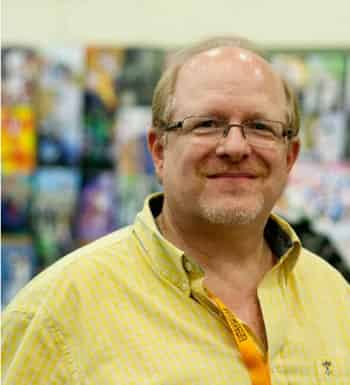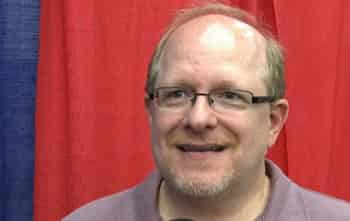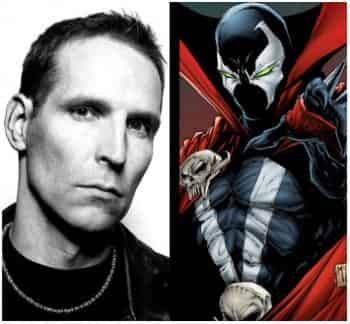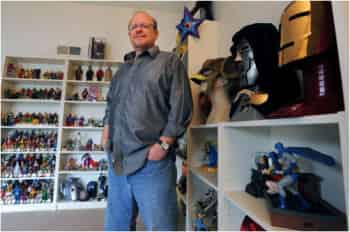
Webcomics
The art of self-promotion
In previous posts, we discussed the DIY trend. We argued that it makes it possible to avoid paying middlemen whose value added is debatable. At the same time we admitted the limits of this formula. However, it is possible to excel in all aspects of a comicbook project.
Todd Allen says that the top quality needed in DIY is self-promotion. “It depends a little on what your profile is and how good a person is at promoting themselves” (“C2E2: Digital Comics: The Next Page,” www.comicsbeat.com, April 29, 2014). This isn’t as easy as it sounds. Mark Waid, who is involved in the Thrillbent project, a webcomic publication platform, has this to say:
There are four factors to selling anything: content, distribution, publicity, and marketing. We are great at content; we are good at distribution. Because of the limited amount of time in the day, however, marketing and publicity is where we fall down. That’s no fault of the people at Thrillbent behind the scenes; that’s on me – I don’t have as much time as I’d like to pound the drum and get people to swarm to our site. (“Interview: Mark Waid on the Inner Demons of Daredevil, Attitude Adjustment for the Hulk, and the Thrill of Digital Comics,” www.comicsbeat.com, February 10, 2014).
We’re not looking for excuses, but if promotion is hard for an established artist like Mark Waid, then it’s surely a major issue for us mere mortals.
What’s a digital comic?
To answer this question, we again turn to the words of Mark Waid, who here explains what a digital comic is not:
Waid immediately jumped in, saying they aren’t cheap animation and that “motion comics are the devil’s tools.” His follow-up points demonstrated a thoughtful approach. He thinks that what makes comics is the reader’s ability to determine the pace of the story. The ability for the reader to fill in the voices and what happens in the gutters, using imagination, makes comics an immersive medium. (“C2E2: Digital Comics: The Next Page,” www. comicsbeat.com, April 29, 2014).
At the same time, some analysts say it’s harder to lose money with digital than with paper editions (Janelle Asselin, “The Economics of Digital Comics: Journalist And Educator Todd Allen On His Important New Book,” www.comicsalliance.com, July 15, 2014). We would qualify this statement a little. If you do everything from A to Z, we’ll grant that a digital comic book is cheaper to produce. But what shape will you give your digital version? If you just copy existing architecture, sure, you’ll save money. But competition in the digital world is stiff and works on two levels (in our view): 1) We feel the digital architecture must differentiate itself in various ways to take full advantage of the Internet’s potential. 2) The Internet requires a rate of posting that can capture and maintain the reader’s interest. Both of these demands require an investment.
Internet, format and action
Mark Waid introduces two interesting ideas that, in our opinion, become conflated. The first isn’t really new: “Remember: this is what media does. Radio up until the 1960s was two or three formats. Now it’s a million formats. Television? Same thing. Three channels becomes a hundred channels. Any medium eventually fragments out towards a wider base of people where each individual fragment does what it has to do to survive on its own. It doesn’t have to appeal to the wider base. In retrospect, it’s kind of amazing and surprising that something that’s been around for 75 years like print comics hasn’t sort of gone through that same dissolution. Instead it’s put all of its eggs into the one basket.” (“CR Holiday Interview # 22 – Mark Waid,” January 10, 2013, www.comicsreporter.com). This promotes the fragmentation of tastes, where a consumer can more easily find something that appeals to him or her. However it also makes for smaller markets, which then brings up the issue of profitability, or more concretely, of how to limit costs on these projects.
However, from a writing point of view, the story should be compatible with its publication format. And here is where Waid brings up his second point, a more original one: “That’s what you have Marc Guggenheim for. That’s what you have comics writer Marc Guggenheim slash lawyer Marc Guggenheim for. He’s on speed dial. I take the same approach that Stan and Gerry Conway and a lot of other guys who’ve written Daredevil in the past have taken, that is that you want to try to be very, very faithful to the law, but not to the point where it stifles your story. And you kind of have to give it some leeway. Especially nowadays, nobody wants twelve pages of Matt Murdock in a courtroom, because comics don’t do that well, television does it better and for free.” (Christine, “Mark Waid talks Daredevil at Baltimore Comic Con”, September 7, 2013, www.theothermurdockpapers.com). This would imply that some formats are better adapted, or more natural, for exploring certain themes or certain types of production. That’s certainly something to think about.
Self-promotion
Twenty years before Web publication was possible, Todd McFarlane had already identified the main benefits of auto-production: “I don’t got no lawyers. I don’t got no PR people. I don’t got no licensing people. I ain’t got shit! I hate to say it but I just proved that half those jobs at Marvel and DC are worthless. They could get rid of all of those guys and it’s not really going to affect the sales of their comic books, if you’re doing a comic book that taps into the heart of what the kids want right now. You don’t need a battery of people to produce big sales. What you need is a comic book that’s either good, glitzy, or happens to be tapping into whatever’s hot that week” (Gary Groth, “…That’s the Spice of Life, Bud: The Todd McFarlane Interview,” The Comics Journal, #152, August 1992).
Promotion
Here are a few excerpts from an article by Hannah Means-Shannon, reporting on comments made during WonderCon 2013 by people involved in marketing at comic book firms:
- “Trying different approaches and continuing to do so as long as possible is key;”
- “Knowing the pitch well, and the many angles from which it might be interpreted, breaking out of narrow genre definitions, for instance, may win the day;”
- “You have to believe in what you’re selling” and believe that you are “one of the best advocates for it.”
Marketing your characters may stunt their development
Mark Waid has expressed an interesting opinion about seeking profit with Web publications: “Waid commented that the tendency toward merchandizing may encourage the slow-down or freeze of new developments in a character since ‘every character becomes a beach towel’ in the end” (Hannah Means-Shannon, “On the Scene: WonderCon 2013,” comicsbeat.com, March 30, 2013.). This simple comment summarizes the conflict that may arise between financial profitability and artistic integrity.






